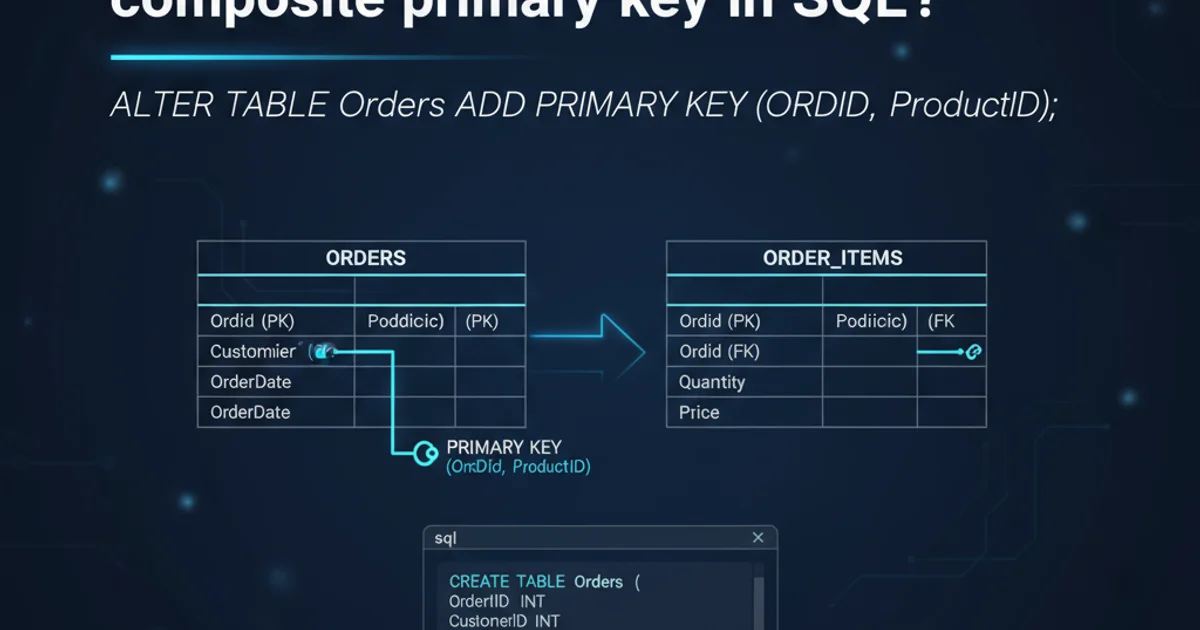How can I define a composite primary key in SQL?
Mastering Composite Primary Keys in SQL Databases

Learn how to define and effectively use composite primary keys in SQL to ensure data integrity and establish unique record identification across multiple columns.
In relational databases, a primary key uniquely identifies each record in a table. While a single column often suffices, there are scenarios where a combination of two or more columns is required to guarantee uniqueness. This combination is known as a composite primary key. Understanding how to define and utilize these keys is crucial for robust database design and maintaining data integrity.
What is a Composite Primary Key?
A composite primary key is a primary key that consists of two or more columns. The values in these combined columns must be unique for each row in the table. Individually, each column in the composite key might not be unique, but their combination must be. This is particularly useful when a single column cannot inherently provide uniqueness for a record.
Student_Course table linking Students and Courses.Defining Composite Primary Keys in SQL
The syntax for defining a composite primary key varies slightly depending on whether you are creating a new table or altering an existing one. The key principle remains the same: list all the columns that form the composite key within the PRIMARY KEY constraint.
erDiagram
STUDENTS ||--o{ STUDENT_COURSES : "registers for"
COURSES ||--o{ STUDENT_COURSES : "has"
STUDENTS {
INT student_id PK
VARCHAR student_name
}
COURSES {
INT course_id PK
VARCHAR course_name
}
STUDENT_COURSES {
INT student_id PK, FK
INT course_id PK, FK
DATE enrollment_date
}Entity-Relationship Diagram illustrating a composite primary key in a junction table.
Creating a Table with a Composite Primary Key
When creating a new table, you can define the composite primary key directly within the CREATE TABLE statement. This is the most straightforward approach.
CREATE TABLE StudentCourses (
student_id INT NOT NULL,
course_id INT NOT NULL,
enrollment_date DATE,
grade VARCHAR(2),
PRIMARY KEY (student_id, course_id)
);
SQL statement to create a table with a composite primary key.
Adding a Composite Primary Key to an Existing Table
If you need to add a composite primary key to a table that already exists, you can use the ALTER TABLE statement. Before adding the constraint, ensure that the combination of values in the specified columns is already unique for all existing rows; otherwise, the operation will fail.
ALTER TABLE StudentCourses
ADD CONSTRAINT PK_StudentCourse
PRIMARY KEY (student_id, course_id);
SQL statement to add a composite primary key to an existing table.
SELECT student_id, course_id, COUNT(*) FROM StudentCourses GROUP BY student_id, course_id HAVING COUNT(*) > 1; to check for duplicates.Benefits and Considerations
Composite primary keys offer several benefits, primarily ensuring data integrity in complex relationships. They prevent duplicate entries where a single column isn't sufficient for unique identification. However, they can also introduce considerations:
- Indexing: A composite primary key automatically creates a unique index on the combined columns, which can improve query performance for lookups involving these columns.
- Foreign Keys: When another table references a table with a composite primary key, its foreign key must also be composite, referencing all columns of the primary key.
- Complexity: They can make queries slightly more complex, as all key columns must be included in
JOINconditions orWHEREclauses for direct lookups.
CREATE TABLE Enrollments (
enrollment_id INT PRIMARY KEY AUTO_INCREMENT,
student_id INT NOT NULL,
course_id INT NOT NULL,
enrollment_date DATE,
FOREIGN KEY (student_id, course_id) REFERENCES StudentCourses(student_id, course_id)
);
Example of a foreign key referencing a composite primary key.